People
Meet Manuel Solano, the Artist Who Paints Flamboyantly Feathered Dinosaurs and ‘Basic’ Celebrities
The artist has overcome blindness and art-school apathy to conjure a jurassic camp world.

The artist has overcome blindness and art-school apathy to conjure a jurassic camp world.

William Van Meter

In “Ancestry,” Manuel Solano’s vividly intriguing solo painting exhibition at London’s Carlos/Ishikawa gallery, the artist uses the theme of under-representation of feathered dinosaurs as a jumping off point to a litany of tangents. “It’s definitely autobiographical,” said Solano, who was a dinosaur geek as a kid.
The show is on view until January 21. “The idea for this series came to me in a flash, but dinosaurs have been on my mind all my life,” Solano explained. “I had a dream where, thanks to science like in Jurassic Park, humans had figured out a way of bringing dinosaurs back. Me and my friend Damien (he’s no longer with us and passed in 2019) were wading in the ocean, waist high in the water. It was like we were swimming with dolphins, but they were ichthyosaurs. I don’t think of myself as very religious or spiritual, but there’s some of that inside me somewhere.”
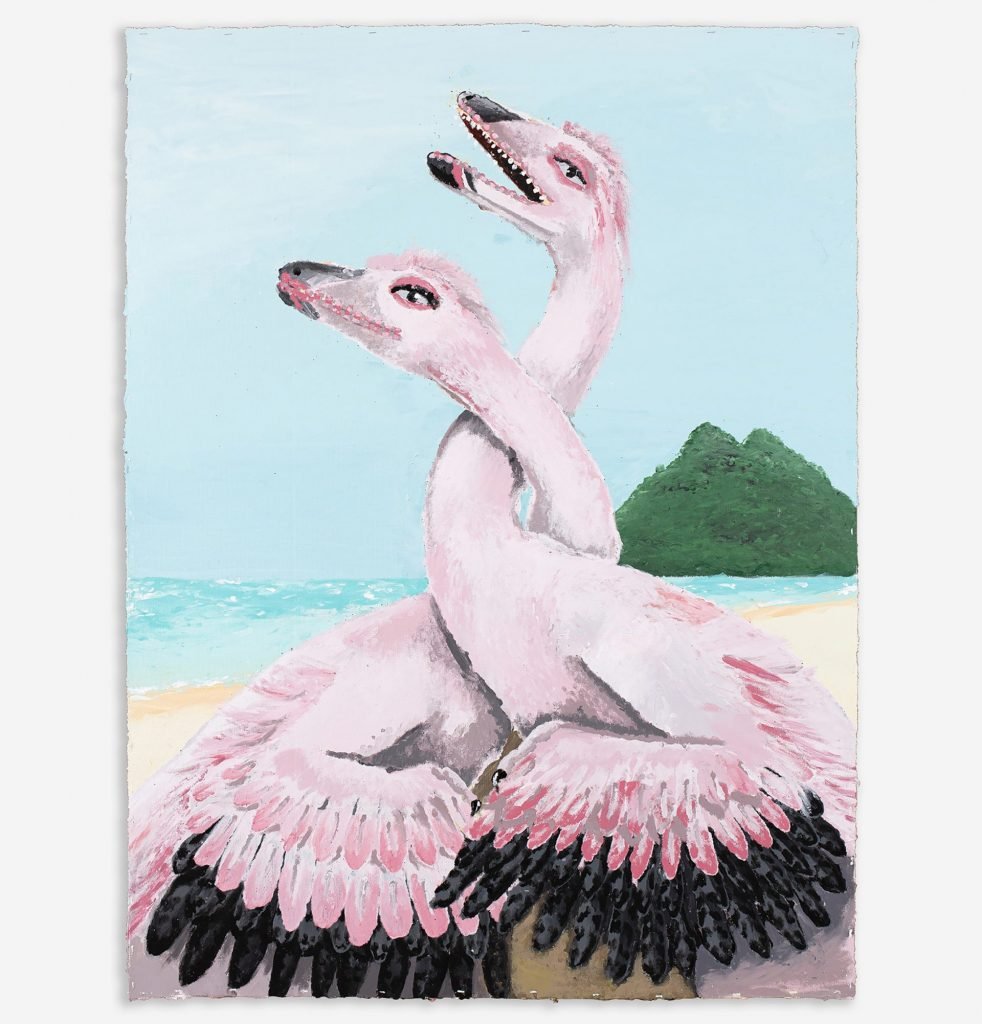
Flamingos 1 (2022). Acrylic on canvas. © Manuel Solano 2022, courtesy the artist; Carlos/Ishikawa, London; and Peres Projects, Berlin / Milan / Seoul
Solano continued retelling the dream, “Humanity had adopted this outlook that rather than God, there is nature. The thing that so many religions call God, or what many people conceive of as the greater spirit is actually nature. Nature manifests itself as evolution. It’s always looking to perfect itself. Dinosaurs were the pinnacle of evolution. They had completely populated the earth, taken every niche in the ecosystem. It had been a cosmic mistake that this asteroid crashed into the earth and wiped them out.”
The rejection of science, patriarchal narrative domination, myth versus fact. It’s all there and more in a series of flamboyantly plumed beasts. They’re purposely more mincing than menacing, but deceptively irreverent. “It’s giving the finger to conservatism,” Solano said of the show.
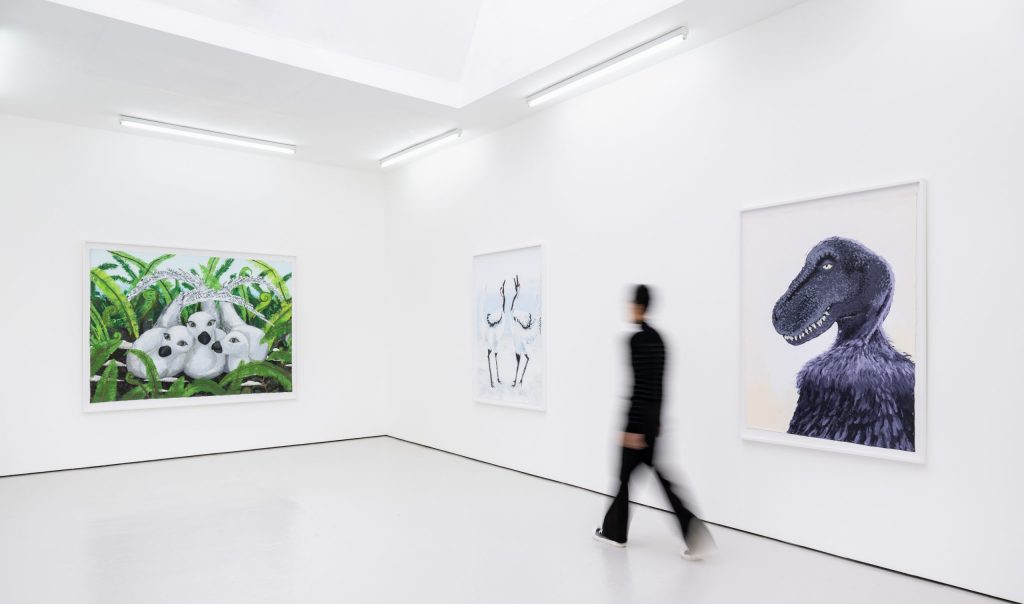
Installation view, “Ancestry,” Carlos/Ishikawa, London, 2022. All images © Manuel Solano 2022, courtesy the artist; Carlos/Ishikawa, London; and Peres Projects, Berlin. Photographer: Damian Griffiths
The Mexico City-born artist is blind and transgender. But these factors aren’t the main reasons their art is so compelling; it’s the work itself. Manuel lost their sight in 2014 at the age of 26 due to an AIDS-related infection. They defiantly and brashly titled their 2014 series “Blind Transgender with AIDS.” The paintings are turgidly messy and emotionally raw, their meaning convoluted with elements of queer gallows humor and celeb cameos from the likes of Cher.
Six of the works were shown earlier this year as part of their first solo outing at Carlos/Ishikawa, “I Still Look Like a Model.” The more uplifting title suits their resilient outlook, and the devastating self-portrait What’s Left of Me, a cyclopean assemblage of wounds, was left out of the show. Their exuberant third solo show of 2022, “The Top of Each Ripple,” wrapped at Dundee Contemporary Arts in November.
Now based in Berlin, Solano’s scope and potential are ever-expanding. We chatted last week about sexist dinosaurs, hitting rock bottom and bouncing back, and the importance of lowbrow queerness in high art.
I was wondering why some queer and trans kids have a deep connection to dinosaurs. I was thinking of this kind of two-spirit aspect of them with the feathers.
Humans everywhere throughout history have attached spiritual meaning to animals. It’s in our nature to see animals as manifestations of a greater spirit or even as evidence of a mastermind behind things. Nature tried so many different things with dinosaurs and ended up figuring out birds instead.
Part of your exhibition focuses on pop culture’s rejection of science pertaining to certain dinosaurs being feathered. This connects to some heavy topics, such as how myths can be more important than truth.
The reason why we don’t see feathered dinosaurs is specifically male behavior conservatism.
I don’t understand how this is patriarchal.
When you think about dinosaurs as a product, not as a scientific objective study, when you think of dinosaur movies, toys, everything—it’s marketed for boys and young men. The values that are attached to them are values that we normally attach to masculinity—for example, physical strength and fierceness. Dinosaurs are dangerous or scary animals, right? Birds are delicate and elegant. Obviously, birds and dinosaurs don’t have the same gender stereotypes as we do. I saw these two things that shouldn’t overlap, human behavior and animal behavior.
So, I made a whole series of dinosaurs, which are kind of going the opposite way. Not only do they have feathers and bright colors, they are even more flamboyant and campy. If it’s allowed to disregard scientific evidence in the service of preserving the masculinity of young boys, it should also be okay to disregard science in the service of uplifting the queerness of little queers.
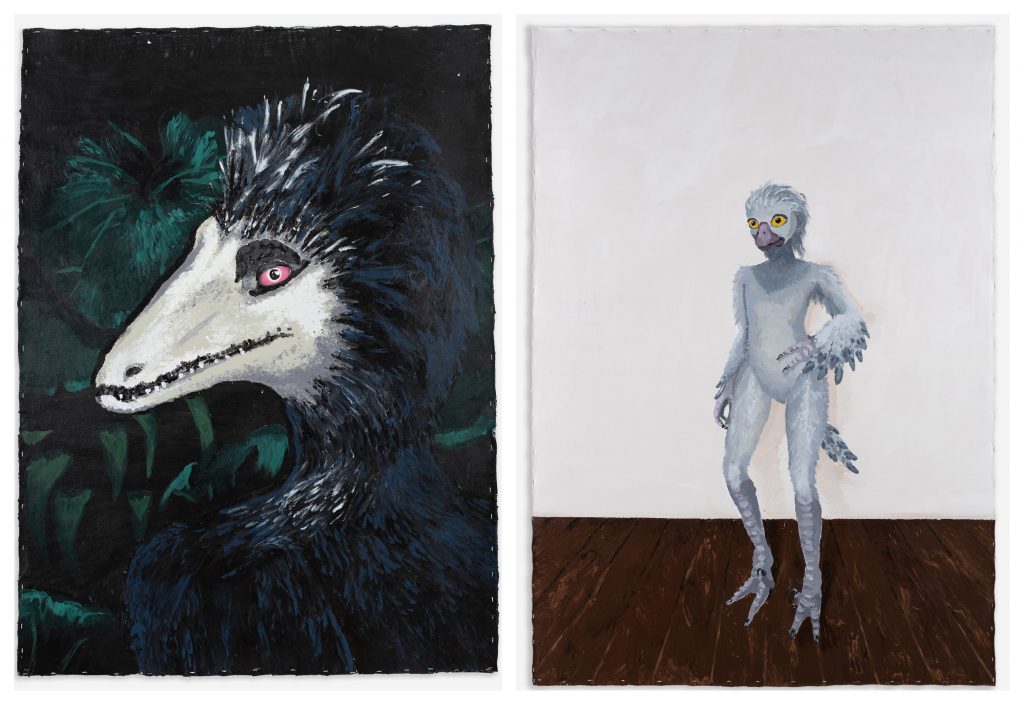
Siouxsie (2021), Dinosauroid (2022). Acrylic on canvas. © Manuel Solano 2022, courtesy the artist; Carlos/Ishikawa, London; and Peres Projects, Berlin / Milan / Seoul
I love old, anatomically incorrect natural history museum paintings of dinosaurs. We kind of haven’t moved on from that.
Dinosaurs are simultaneously sacred and ridiculous. It’s part of our animal nature to find magic in nature, I would say. And that’s why we’re so interested in animals and nature.
You often weave pop culture references into your work, this series references David Bowie and Siouxsie Sioux, you’ve depicted a broad scope of actors like Robin Wright.
It’s always about me wanting to be like these people. For example, David Bowie. I do like some of his music and I recognize that he was a monumental artist, but what really captured me the first time was the Life on Mars video. I wish there was a music video of me looking that good. Each of my works has a story. It’s never just because it looks good. Even if it’s a portrait of Charlotte Gainsbourg for some art fair somewhere, it’s because I saw myself in the mirror when I was very sick with AIDS and I saw my sternum. And I remember thinking, Oh well, at least I have Charlotte Gainsbourg’s sternum.
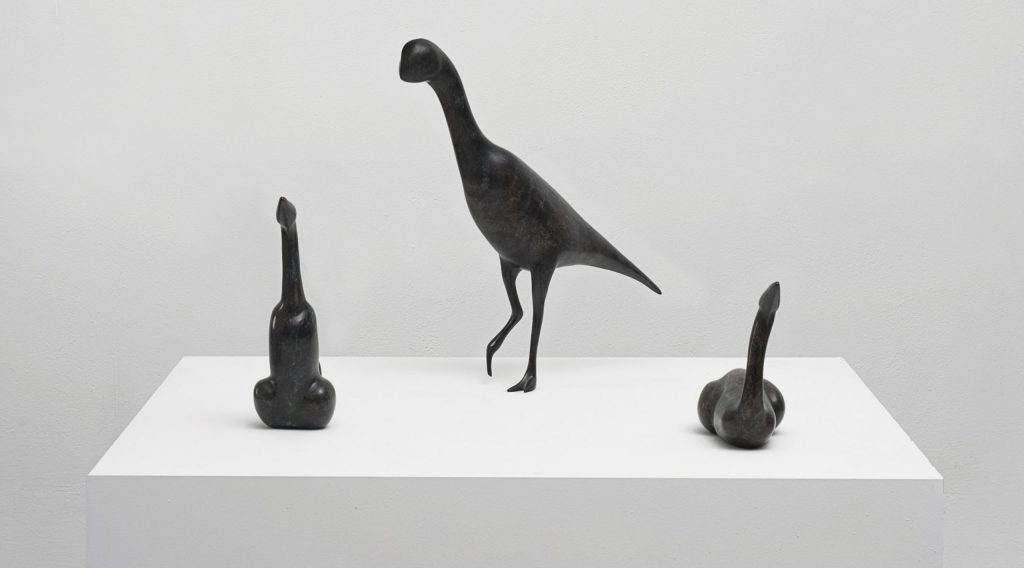
Untitled (from the series Hommage à Pompon), 2018 Bronze, painted and lacquered, in 3 parts. Photo: courtesy Peres Projects Berlin. © Manuel Solano 2022, courtesy the artist; Carlos/Ishikawa, London; and Peres Projects, Berlin / Milan / Seoul
You’re a multimedia artist. You’ve done performance, videos, sculpture. I would assume that after becoming blind that you would concentrate on other mediums.
Honestly, it’s just the way things happened. It was never a conscious decision going back to painting after I became blind. That’s what I had there in front of me in my studio. I had some paints and some paper. I often feel like I should have concentrated on sculpture. I do remember this nagging fear that I should not do the obvious—that if I became blind but still wanted to be an artist, people would assume that I would make sculptures. Or that if I was gonna paint, I would make abstract paintings.
I concentrate on figurative painting because I didn’t want the easy way out. In some ways, I feel like I’ve put my foot in my mouth because my work is always becoming more complex and detailed. Sometimes I wonder if my life wouldn’t be easier if I just splattered paint on canvas.
Can you talk about your process a little bit?
My paintings always start from a mental image. Either a memory I have of something I saw or something I am building up in my mind, something I’m imagining. Nowadays, I work with a team of people who are sighted and who can make a sketch and mix colors for me. A lot of communication and a lot of touch are our key ingredients.
I describe things in as much detail as I can to my team so that when there’s references to be Googled, and they then need to describe images to me in a lot of detail. I also need to know what to ask. For example, if we’re looking to make a portrait of somebody, I need to ask the right questions. Is she smiling and looking over her shoulder? What’s the characteristic of her face that makes it her own? Is it the separation of her eyes or the curve of her upper lip?
I use my sense of touch for everything all the time. For instance, if one of my assistants makes a pencil sketch, we then trace my finger over it so that I start becoming familiar with the composition and then they lay it out on the canvas. Once I approve of it, they lay it out on the canvas in pipe cleaners and strings and nails so that I can touch it on the canvas.
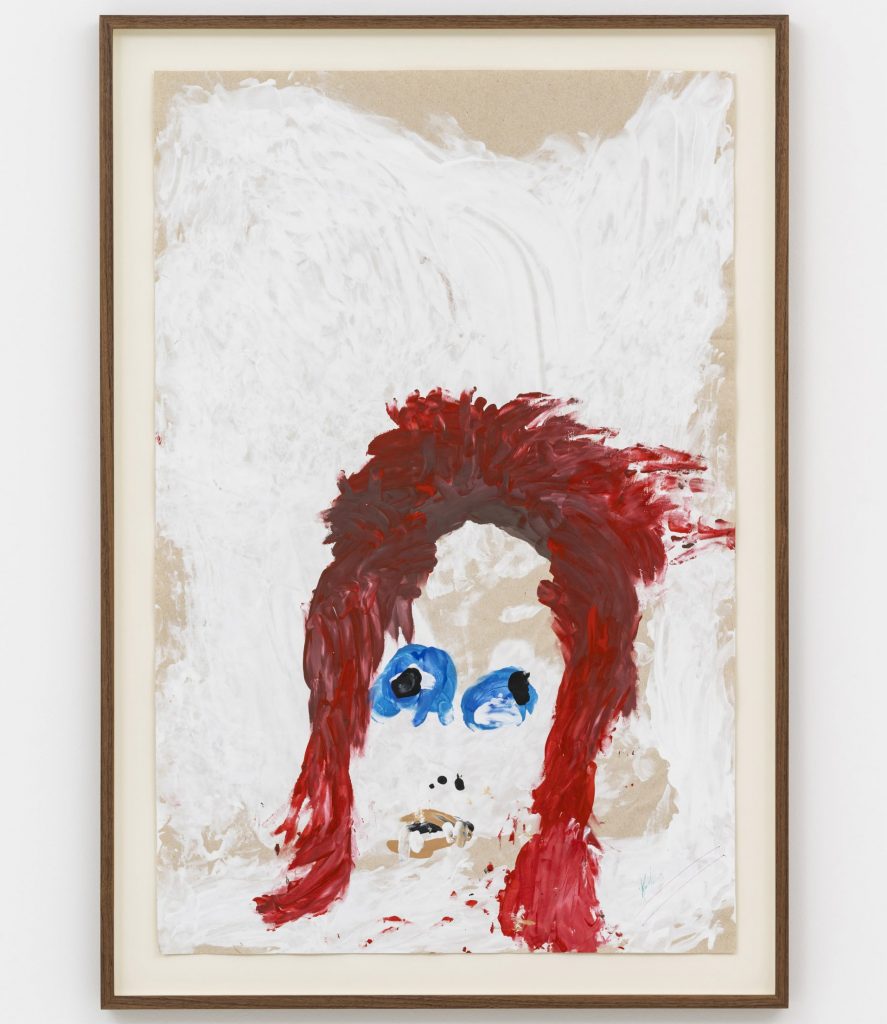
Please Send Help (2014) from the series “Blind Transgender With AIDS.” Acrylic on paper. Photo: Damian Griffiths, © Manuel Solano 2022, courtesy the artist; Carlos/Ishikawa, London; and Peres Projects, Berlin / Milan / Seoul
A recent series of paintings I was struck by were the interiors.
Some of them come from memory, some of them don’t. I had two sibling shows at the same time. The one in Sao Paulo was titled “Heliplaza.” A lot of it was from memory. However, the one in, in Lisbon, “Jacuzzi,” was entirely made up.
And that was super challenging. I remembered atmospheres. I remember that my Aunt Anna’s bathroom at some point was black. Like there was a black sink and a black toilet. This felt very ’80s, but I don’t remember what it looked like. I don’t remember what the bathroom, what the toilet looked like or what the sink looked like. I only remember that it was black. We had to spend hours and hours and session after session, me and René working on Googling things. He would describe one image after another and, and I would say, “Yeah, it sounds very ’80s, but it doesn’t sound like what I want.” We had to invent these spaces, and that was super challenging. But it was rewarding in the end. The dinosaurs were by far the most challenging works I’ve ever made.
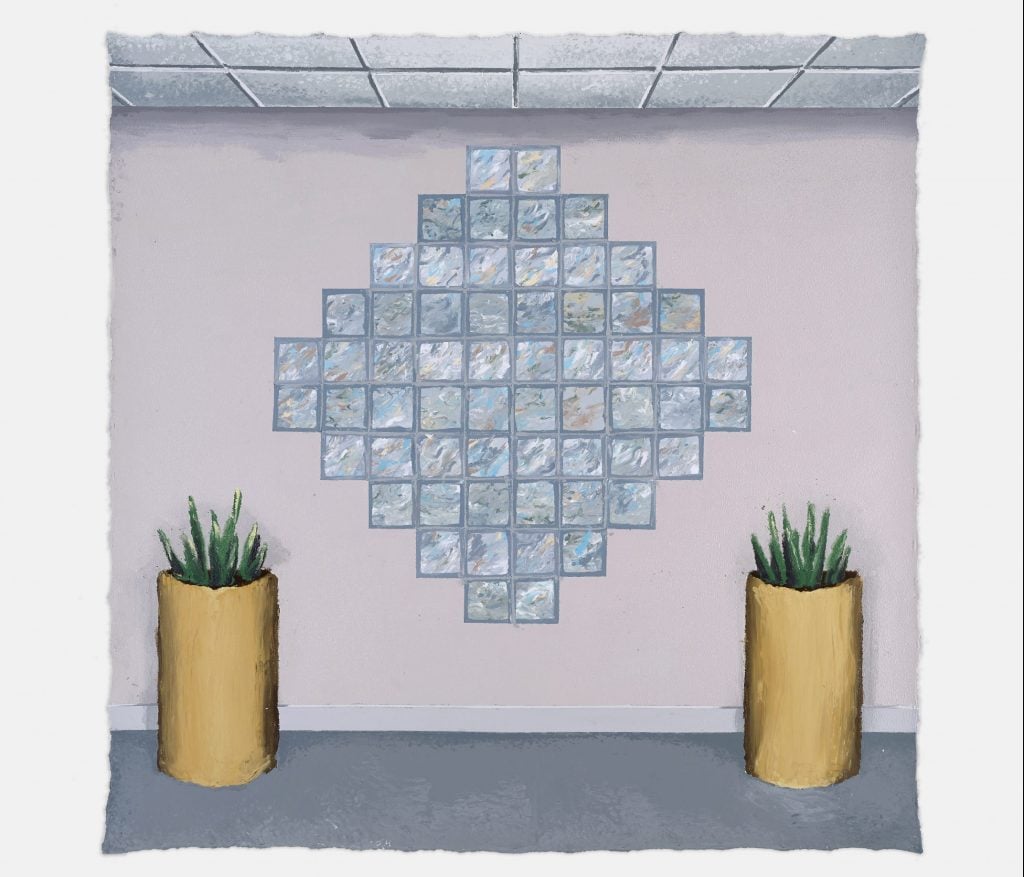
Glass Blocks (2021). Acrylic on canvas. Photo courtesy of Peres Projects Berlin. © Manuel Solano 2022, courtesy the artist; Carlos/Ishikawa, London; and Peres Projects, Berlin / Milan / Seoul
What are you working on next?
In a way, this feels like my epitaph. I hope I won’t die that soon, but it feels like the most me show that I’ll ever do. René is my number one teammate. He’s also my best friend and ex-boyfriend. This year I put him in one of my paintings. Ever since we started working together in 2017, he’s kept a list of ideas I’ve had around him.
It’s a big body of work that I want to split into two sister exhibitions. I don’t know how I’m gonna pull this off, but I want to open simultaneously one show in Berlin and one in Mexico City. I don’t want to reveal any of the subject matter, but there’s a lot of camp and sci-fi, a lot of what I call glamorous aggressivity. We recently finished a painting of an American pop singer from the early 2000s whom I categorized as alternative basic. I’m gonna have to include a basicness trigger warning.
It seems that the B.C. and A.D. of Manuel Solano, is this life change from Mexico City to Berlin.
Looking back on it, yeah, it was in a way a rebirth. I moved here in August 2019. I wasn’t aware of it as much at the time, but I see now that I needed to be in a place where I felt safe in the longer term in Mexico. I knew that my career was taking off and that’s great, but there was no safety net in Mexico for me, other than my family. And I didn’t want to depend on my family for the rest of my life. In Germany I have state funded health insurance. I have a retirement fund for artists. It’s a better place to be a disabled human. And socially speaking, people treat me different. I’ve never been able to put a finger on why, but I feel different here.
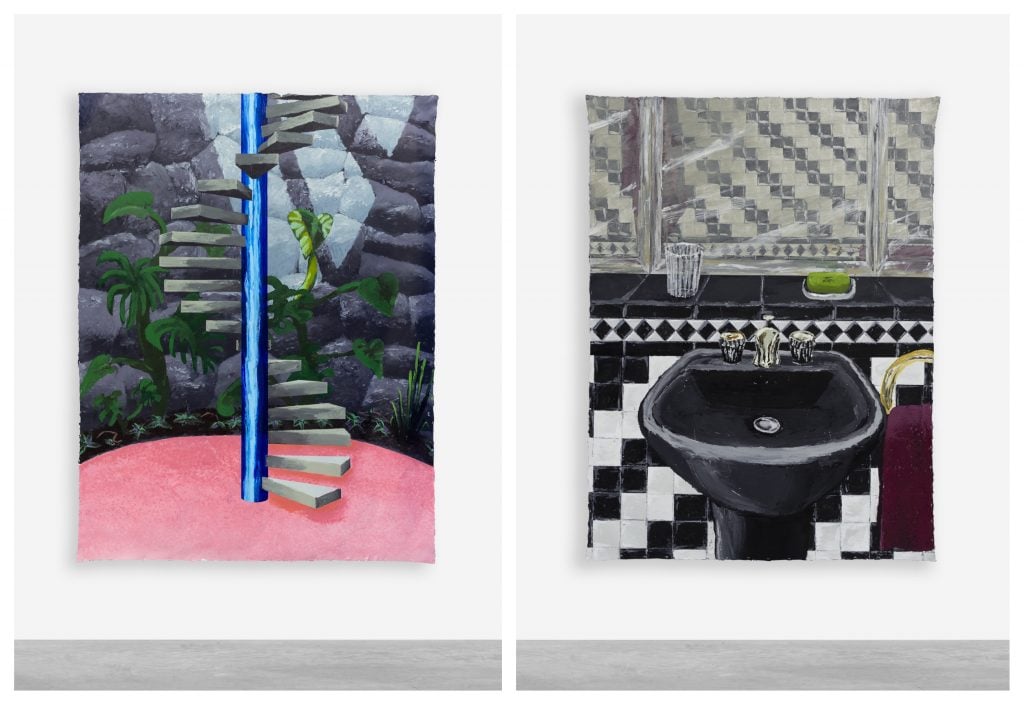
Escalera (2021), Lavabo (2021). All images: © Manuel Solano 2022, courtesy the artist; Carlos/Ishikawa, London; and Peres Projects, Berlin / Milan / Seoul
I feel more normal here. Also, I started transitioning, or at least medically transitioning only a couple months before I moved to Berlin. So this process was completely, um, it sounds like a lot to undertake, moving to a different country, signing with a new gallery, and also taking on a new gender role. But it was kind of the perfect way to do it, if you ask me. It all felt like jet lag. As the jet lag started wearing off, my worries started wearing off. I make it sound too easy, but in a way, I didn’t really have to think about it so much. My transition would’ve been way more difficult if I had stayed in Mexico.
I had a lot of frustration and resentment, especially throughout my last year in Mexico. After the [2018] “New Museum Triennial,” my work started getting a lot of attention in the art world. I would get interviewed for The New York Times or studio visits with rich New York gallerists saying, “If you let us take 60 percent it’s gonna be very good for you.” They’d come into my mom’s basement, and always ask the same questions, then they’d leave to have some fancy dinner.
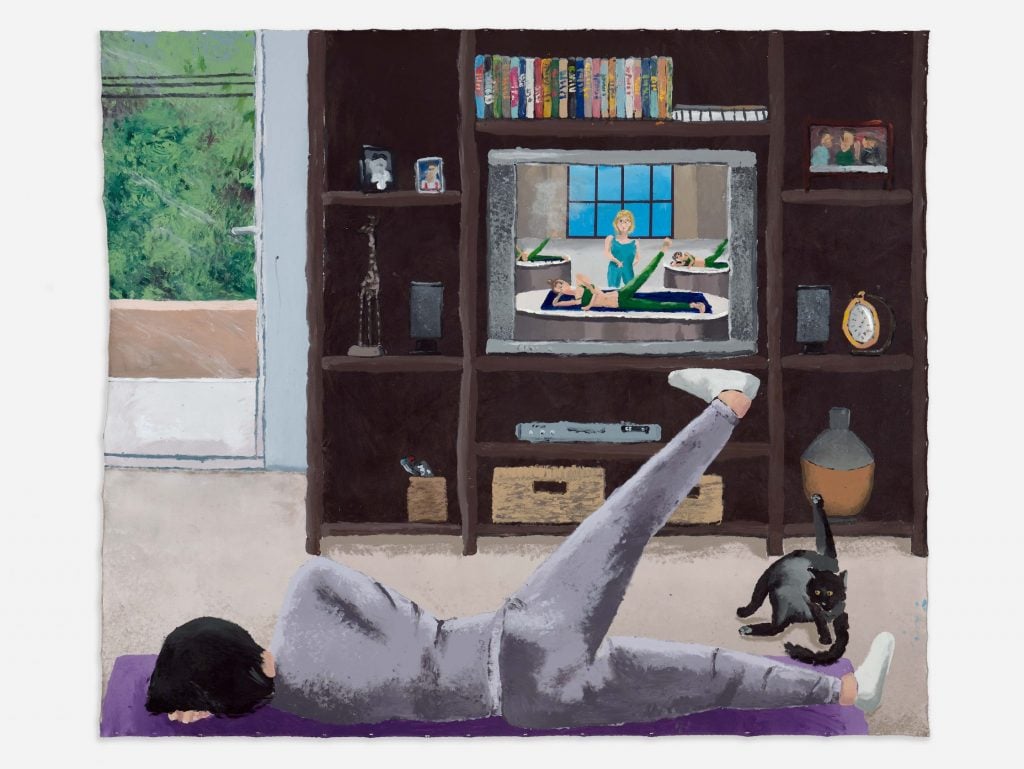
Pilates (2021). Acrylic on canvas. Photo: courtesy Peres Projects © Manuel Solano 2022, courtesy the artist; Carlos/Ishikawa, London; and Peres Projects, Berlin / Milan / Seoul
I would have to call my mom and baby brother and say, “Hey, they’re gone now. Can you help me roll up my paintings and put ’em in the tubes?” And I would cry. It was so fucked up. A lot of very horrible things happened around that show. I was suicidal. I wanted to die.
I thought, How is this possible? I survived a horrible disease and grieved the loss of my eyesight and learned to paint again. My career picks up, and then I’m in this big show and I’m still in the same fucking place. How can all of this happen and my situation still not change? I was losing my mind. I eventually did find a way to get what I needed. But I lost a lot on the way. I had to sacrifice a lot. I had to take a lot of abuse.
I’m very grateful that I’m finally in a place where I can actually feel safe and actually say that I’m in the best place in my life. Even though I can’t see, I feel the happiest now that I’ve ever been.
Did blindness change the trajectory of what your work would’ve been?
Yes and no. The attitude is the same. I’ve always been rather irreverent and I’ve always had the impulse to rebel. I saw this video by a genius, if there ever was one, the artist David Hoyle. He used to go by the name the Divine David in the ’90s. He’s supposedly teaching the audience to paint a portrait. That video changed me for life when I saw it in 2011, when I could still see. It’s a very flamboyant, spontaneous, and irreverent way of approaching art while still making very solid art.
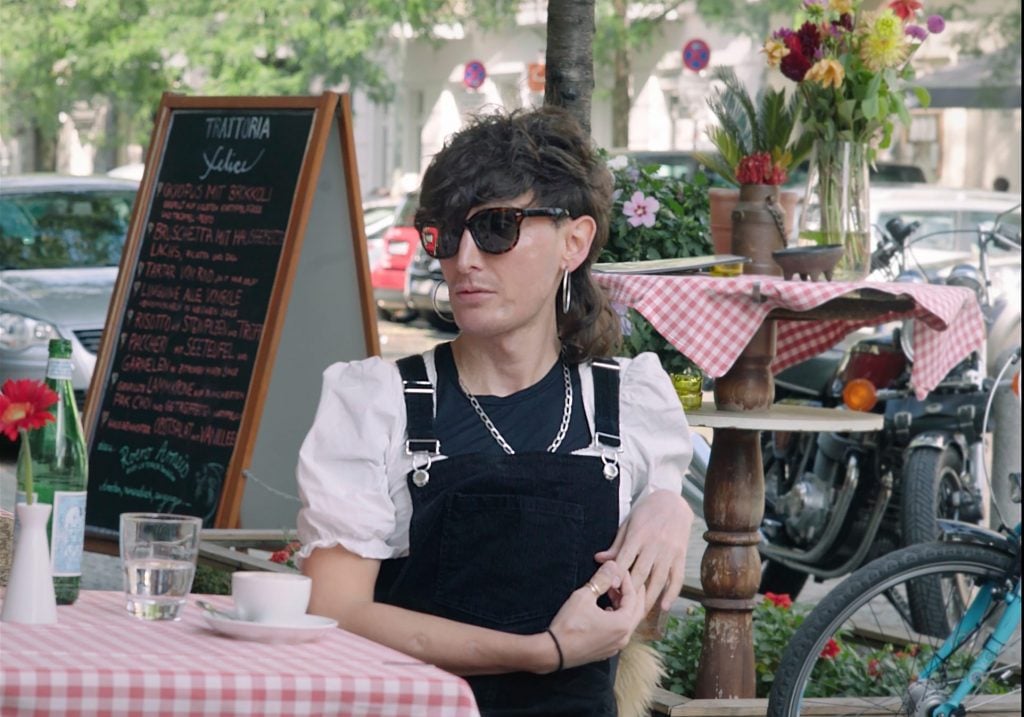
A video still from Cappuccino, 2019. © Manuel Solano 2022, courtesy the artist; Carlos/Ishikawa, London; and Peres Projects, Berlin / Milan / Seoul.
I studied in France one semester. In Mexico, in art school [at La Esmerelda] I was met with apathy from school and classmates. In Lyon, I was met with apathy and criticism. My position was to become increasingly more like the Divine David. They don’t like it when when I don’t take art seriously? Ok, then I’m gonna make all these ugly portraits of Rihanna and abstract paintings that look like posters from the ’80s. You don’t like how queer I am? I’m going to dress even more queer.
What’s your vibe in Berlin besides churning out art.
I’ve been playing the guitar since 2016. I’m slowly getting better. Last fall, songs started coming out of me. I’m not a musician yet, but I’m starting to write some music. If I could choose, I wouldn’t be a painter or a visual artist. “I should have been a rock star, but I can’t sing.” That’s a quote from my favorite movie, Gia, starring Angelina Jolie.